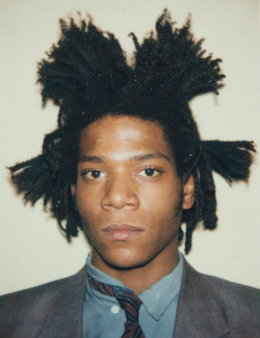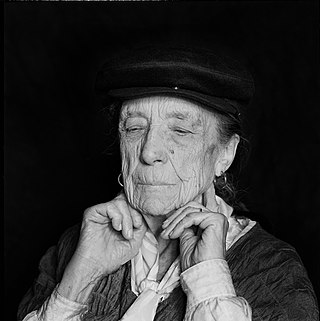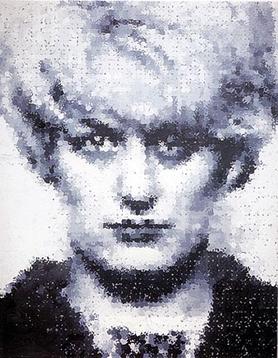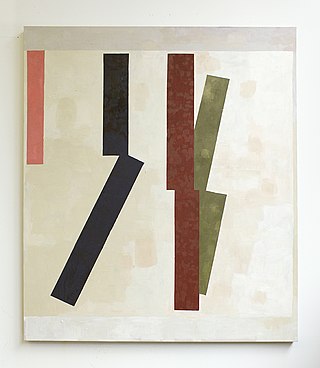Related Research Articles

Andy Warhol was an American visual artist, film director, producer, and leading figure in the pop art movement. His works explore the relationship between artistic expression, advertising, and celebrity culture that flourished by the 1960s, and span a variety of media, including painting, silkscreening, photography, film, and sculpture. Some of his best-known works include the silkscreen paintings Campbell's Soup Cans (1962) and Marilyn Diptych (1962), the experimental films Empire (1964) and Chelsea Girls (1966), and the multimedia events known as the Exploding Plastic Inevitable (1966–67).

Jean-Michel Basquiat was an American artist who rose to success during the 1980s as part of the Neo-expressionism movement.

Louise Joséphine Bourgeois was a French-American artist. Although she is best known for her large-scale sculpture and installation art, Bourgeois was also a prolific painter and printmaker. She explored a variety of themes over the course of her long career including domesticity and the family, sexuality and the body, as well as death and the unconscious. These themes connect to events from her childhood which she considered to be a therapeutic process. Although Bourgeois exhibited with the abstract expressionists and her work has much in common with Surrealism and feminist art, she was not formally affiliated with a particular artistic movement.

Louise Nevelson was an American sculptor known for her monumental, monochromatic, wooden wall pieces and outdoor sculptures. Born in the Poltava Governorate of the Russian Empire, she emigrated with her family to the United States in the early 20th century. Nevelson learned English at school, as she spoke Yiddish at home.

The Jewish Museum is an art museum and repository of cultural artifacts, housed at 1109 Fifth Avenue, in the former Felix M. Warburg House, along Museum Mile on the Upper East Side of Manhattan, New York City. The first Jewish museum in the United States, as well as the oldest existing Jewish museum in the world, it contains the largest collection of art and Jewish culture excluding Israeli museums, more than 30,000 objects. While its collection was established in 1904 at the Jewish Theological Seminary of America, the museum did not open to the public until 1947 when Felix Warburg's widow sold the property to the Seminary. It focuses both on artifacts of Jewish history and on modern and contemporary art. The museum's collection exhibition, Scenes from the Collection, is supplemented by multiple temporary exhibitions each year.
Ileana Sonnabend was a Romanian-American art dealer of 20th-century art. The Sonnabend Gallery opened in Paris in 1962 and was instrumental in making American art of the 1960s known in Europe, with an emphasis on American pop art. In 1970, Sonnabend Gallery opened in New York on Madison Avenue, and in 1971 relocated to 420 West Broadway in SoHo where it was one of the major protagonists that made SoHo the international art center it remained until the early 1990s. The gallery was instrumental in making European art of the 1970s known in America, with an emphasis on European conceptual art and Arte Povera. It also presented American conceptual and minimal art of the 1970s. In 1986, the so-called "Neo-Geo" show introduced, among others, the artist Jeff Koons. In the late 1990s, the gallery moved to Chelsea and continues to be active after Sonnabend's death. The gallery goes on showing the work of artists who rose to prominence in the 1960s and 1970s including Robert Morris, Bernd and Hilla Becher and Gilbert & George as well as more recent artists including Jeff Koons, Rona Pondick, Candida Höfer, Elger Esser, and Clifford Ross.
Mara Devereux is an American artist.
Louise Fishman was an American abstract painter from Philadelphia, Pennsylvania. For many years she lived and worked in New York City, where she died.

Jennifer Bartlett was an American artist and novelist. She was best known for paintings and prints that combine the system-based aesthetic of conceptual art with the painterly approach of Neo-Expressionism. Many of her pieces were executed on small, square, enamel-coated steel plates that are combined in grid formations to create very large works.

The Derfner Judaica Museum is a cultural and educational center that provides exhibitions relating to Jewish history and contemporary Jewish culture. The museum is located in the Jacob Reingold Pavilion on the grounds of The Hebrew Home at Riverdale in the Riverdale neighborhood of the Bronx in New York City.

Mira Schor is an American artist, writer, editor, and educator, known for her contributions to critical discourse on the status of painting in contemporary art and culture as well as to feminist art history and criticism.

Myra is a 1995 large painting which is a reproduction of the mugshot of Myra Hindley shortly after she was arrested for her participation in the Moors murders and was created by Marcus Harvey in 1995. It was displayed at the Sensation exhibition of Young British Artists at the Royal Academy of Art in London from 8 September to 28 December 1997.

Tania was a Polish-born Jewish American abstract painter, sculptor, collage artist and painter of city walls.

Jeffrey Deitch is an American art dealer and curator. He is best known for his gallery Deitch Projects (1996–2010) and curating groundbreaking exhibitions such as Lives (1975) and Post Human (1992), the latter of which has been credited with introducing the concept of "posthumanism" to popular culture. In 2010, ArtReview named him as the twelfth most influential person in the international art world.

Alice Trumbull Mason (1904–1971) was an American artist, writer, and a founding member of the American Abstract Artists group (AAA) in New York City. Mason was recognized as a pioneer of American Abstraction.

Abshalom Jac Lahav is a New York City–based artist. He is known for his series 48 Jews and The Great Americans which have been shown at museums such as Richmond Art Museum, Samuel Dorsky Museum of Art, The Oregon Jewish Museum and Jewish Museum of Florida. His painting style implements well known images of famous people in the modern contexts, but still references historical modes of painting and black-and-white photography through its use of monotone imagery. He is also the founder of the Midnight Society, an artist run curatorial project based in Brooklyn, New York.

Marla Hamburg Kennedy is an American art curator, dealer and publisher specializing in contemporary art and photography. She is also an author and has published 30 photography and fine art books. She is the founder and owner of Hamburg Kennedy Photographs, HK Art Advisory, and Picture This Publications located in New York City.
Mary Weatherford is a Los Angeles–based painter. She is known for her large paintings incorporating neon lighting tubes. Her work is featured in museums and galleries including the Hirshhorn Museum and Sculpture Garden, Brooklyn Museum, Museum of Modern Art, and the High Museum of Art. Weatherford's solo exhibitions include Mary Weatherford: From the Mountain to the Sea at Claremont McKenna College, I've Seen Gray Whales Go By at Gagosian West, and Like The Land Loves the Sea at David Kordansky Gallery, Los Angeles. Her work has been part of group exhibitions at the Museum of Modern Art and the Rose Art Museum at Brandeis University.
Ten Portraits of Jews of the Twentieth Century is a 1980 series of ten paintings by Andy Warhol. The series consists of ten silk-screened canvases, each 40 by 40 inches. Five editions of the series were made. The series was also produced by Warhol as a portfolio of screenprints on Lenox museum board comprising editions of 200, 30 Artist Proofs, 5 Printers Proofs, 3 EPs, and 25 unique Trial Proofs.

Sharon Butler is an American artist and arts writer. She is known for teasing out ideas about contemporary abstraction in her art and writing, particularly a style she called "new casualism" in a 2011 essay. Butler uses process as metaphor and has said in artist's talks that she is keenly interested in creating paintings as documentation of her life. In a 2014 review in the Washington Post, art critic Michael Sullivan wrote that Butler "creates sketchy, thinly painted washes that hover between representation and abstraction.Though boasting such mechanistic titles as 'Tower Vents' and 'Turbine Study,' Butler’s dreamlike renderings, which use tape to only suggest the roughest outlines of architectural forms, feel like bittersweet homages to urban decay." Critic Thomas Micchelli proposed that Butler's work shares "Rauschenberg’s dissolution of the barriers between painting and sculpture," particularly where the canvases are "stapled almost willy-nilly to the front of the stretcher bars, which are visible along the edges of some of the works."
References
- 1 2 3 4 "Deborah Kass | Blue Deb | The Met". The Metropolitan Museum of Art, i.e. The Met Museum. Retrieved 2018-03-30.
- ↑ "Deborah Kass - 165 Artworks, Bio & Shows on Artsy".
- 1 2 3 Kass, Deborah, and Lisa Liebmann. Deborah Kass: Before and Happily Ever after. New York: Skira Rizzoli, 2012.
- 1 2 3 4 5 6 7 8 "Deborah Kass". designmattersmedia. Retrieved 2019-03-27.
- ↑ "Archived copy" (PDF). Archived from the original (PDF) on 2015-07-10. Retrieved 2015-07-08.
{{cite web}}: CS1 maint: archived copy as title (link) - ↑ The New York Times, Riffing On Forefathers And Mothers, 10/28/2012 The New York Times, retrieved April 25, 2014
- ↑ Has Deborah Kass Saved Warhol Appropriation?, Hyperallergic January 4, 2013, Retrieved April 25, 2014
- ↑ "Deborah Kass".
- ↑ Museum, The Andy Warhol. "Deborah Kass: Before and Happily Ever After". The Andy Warhol Museum. Retrieved 2016-09-11.
- ↑ "The warhol: Deborah Kass: Before and Happily Ever After". Archived from the original on 2015-12-29. Retrieved 2015-11-17.
- ↑ "The Tulane WordPress Network – Supported WordPress Sites for Tulane".
- ↑ Shiner, Eric, Lisa Liebmann, Robert Storr, Griselda Pollack and Brooks Adams (2012). Deborah Kass: Before and Happily Ever after. New York: Skira Rizzoli. ISBN 978-0847839186.
{{cite book}}: CS1 maint: multiple names: authors list (link) - ↑ Johnson, Ken (2015-06-04). "Review: Deborah Kass Takes Mug Shots of the Art World (Published 2015)". The New York Times. ISSN 0362-4331 . Retrieved 2020-12-21.
- ↑ "Press Releases Archives".
- ↑ deborahkass.com
- ↑ Whiting, Sam (January 14, 2020). "'YO': Stanford has a new, bright-yellow social media magnet". San Francisco Arts & Entertainment Guide. Retrieved 2020-03-08.
- ↑ "The Jewish Museum". thejewishmuseum.org. Retrieved 2020-03-08.
- ↑ "Artists".
- ↑ "Deborah Kass with Terry R. Myers". The Brooklyn Rail. 2010-09-03. Retrieved 2023-05-24.
- ↑ "Deborah Kass, Sing out Louise, 2002". Kavi Gupta Gallery. Retrieved 2023-05-24.
- ↑ Zaytoun, Constance (2011). "Enough Already! It's Deborah Kass's Turn to Take the Stage". TDR (1988-). 55 (3): 110–123. doi:10.1162/DRAM_a_00101. ISSN 1054-2043. JSTOR 23017935. S2CID 57560504.
- ↑ "Deborah Kass, AFTER LOUISE BOURGEOIS, 2010". Kavi Gupta Gallery. Retrieved 2023-05-24.
- ↑ "Deborah Kass - NOMEN: American Women Artists from 1945 to Today New York Monday, June 17, 2019". Phillips. Retrieved 2023-05-24.
- ↑ "Deborah Kass, Sing out Louise, 2002". Kavi Gupta Gallery. Retrieved 2023-05-24.
- ↑ "Deborah Kass, After Louise Nevelson, 2020". Kavi Gupta Gallery. Retrieved 2023-05-24.
- ↑ "Patricia Cronin, Deborah Kass: Weddings". The New York Times. 2011-07-22. ISSN 0362-4331 . Retrieved 2019-03-27.
- ↑ "New York Foundation for the Arts". www.nyfa.org. Retrieved 2020-03-08.
- ↑ "DEBORAH KASS: BEFORE AND HAPPILY EVER AFTER | Rizzoli Bookstore". www.rizzolibookstore.com. Retrieved 2020-03-08.
- ↑ "Jewish Identities in American Feminist Art: Ghosts of Ethnicity, 1st Edition (Paperback) - Routledge". Routledge.com. Retrieved 2020-03-08.
- ↑ "Pop Art | Art | Phaidon Store". Phaidon. Retrieved 2020-03-08.